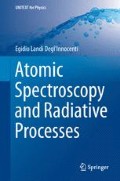Abstract
The spectra of atoms having only one valence electron, considered in the previous chapter, are relatively simple and constitute the only examples where the energy levels can be determined by the solution of the one-dimensional Schrödinger equation.
When we consider atoms with more valence electrons, the treatment becomes considerably more complex, and it is necessary to resort to a number of approximations to make the problem mathematically tractable. This chapter is devoted to introducing the physical basis of these approximations as well as the related concepts which form the basis for the complex terminology commonly used in spectroscopy (configurations, terms, multiplets, multiplicity, quantum numbers, etc.).
Access this chapter
Tax calculation will be finalised at checkout
Purchases are for personal use only
Notes
- 1.
The parity of single-particle wave functions is (−1)l, where l is the azimuthal quantum number. This property is contained within Eq. (6.11). The parity operator corresponds, in fact, to the transformation θ→π−θ, ϕ→ϕ+π.
- 2.
H− is the negative hydrogen ion, i.e. an hydrogen atom with an extra electron. Such an ion is stable and provides a significant contribution to the opacity in stellar atmospheres (see Sect. 14.6).
- 3.
In the case we are considering, in which the wave functions of the electrons are spherically symmetric, this expression for the integral \(\mathcal{I}_{3}\) can also be obtained more directly using simple considerations based on Gauss theorem.
- 4.
- 5.
Hund’s rules apply to terms arising from configurations of equivalent electrons. Here they are applied to terms of configurations of the type 1s nl.
References
Landi Degl’Innocenti, E., Landolfi, M.: Polarization in Spectral Lines. Kluwer Academic, Dordrecht (2004)
Racah, G.: Phys. Rev. 62, 438 (1942)
Author information
Authors and Affiliations
Rights and permissions
Copyright information
© 2014 Springer-Verlag Italia
About this chapter
Cite this chapter
Landi Degl’Innocenti, E. (2014). Atoms with Multiple Valence Electrons. In: Atomic Spectroscopy and Radiative Processes. UNITEXT for Physics. Springer, Milano. https://doi.org/10.1007/978-88-470-2808-1_7
Download citation
DOI: https://doi.org/10.1007/978-88-470-2808-1_7
Publisher Name: Springer, Milano
Print ISBN: 978-88-470-2807-4
Online ISBN: 978-88-470-2808-1
eBook Packages: Physics and AstronomyPhysics and Astronomy (R0)

